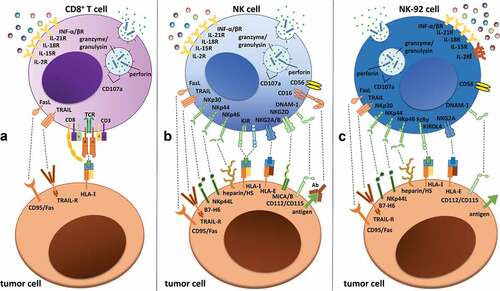Figures & data
Figure 1. Receptor expression and interactions of (a) CD8+ T cells, (b) NK cells and (c) NK-92 cells with tumor target cells. T cells primarily recognize target cells via the TCR–HLA/MHC-I interaction, while NK and NK-92 cell activation depends on highly polymorphic activating and inhibitory germline-encoded receptors, such as KIRs or receptors of the NKG2-family. Activating receptors are shown in green, inhibitory receptors are shown in blue and killer receptors are shown in orange. Interleukin receptors are indicated in yellow, with the IL-2 receptor highlighted in orange on the NK-92 cell to illustrate its strong IL-2-dependency. Please note that only a selection of the most important receptors/ligands are shown, without claim of completeness.Citation3–Citation6Abbreviations: CD, cluster of differentiation; DNAM-1, DNAX accessory molecule-1; HS, heparan sulfate; HLA, human leukocyte antigen; IL, interleukin; INF, interferon; KIR, killer-cell immunoglobulin-like receptor; MHC, major histocompatibility complex; MIC, MHC class I chain-related protein; NKG2, natural killer group 2; TCR, T cell receptor; TRAIL, TNF-related apoptosis-inducing ligand.

Figure 2. Geographical distribution of ongoing NK cell (a) and CAR-NK cell (b) therapy trials worldwide, as registered by mid February 2020 at https://www.clinicaltrials.gov/ with “Cancer (NK AND cell) OR NK-92 OR (natural AND killer AND cell)” as search terms and CAR-NK cell clinical trials as listed in .

Table 1. Overview of CAR-NK cell trials worldwide listed on https://www.clinicaltrials.gov/. Trials are classified based on the source of NK cells used, and then within these sub-clusters based on their geographical distribution. Trials targeting hematological malignancies are highlighted in light blue and CAR-NK cell trials against solid tumors are highlighted in light gray.
